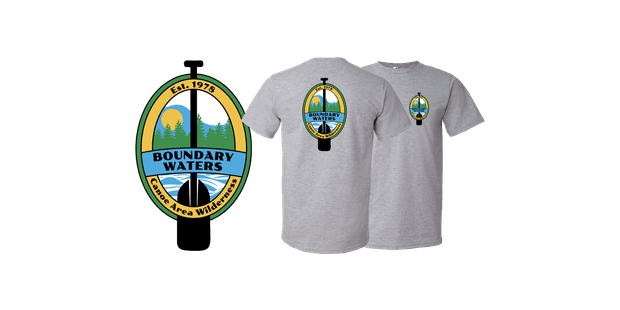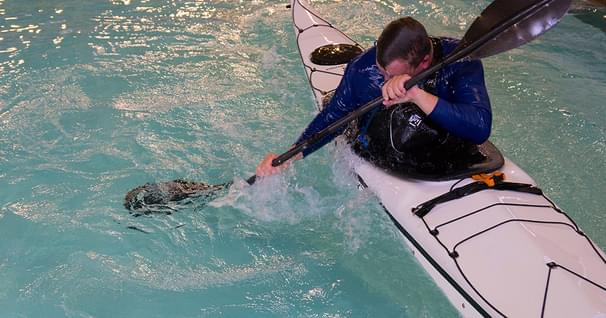How To Paddle Straight
Photo Credit: Darlene Patterson
Many people who have paddled for years can't keep a canoe on a straight course without constant wavering. What are they doing wrong? Heading the list is their correctional stroke which, more often than not, is the "thumbs-up-J" or what Bill Mason, in his wonderful book, "Path of the Paddle", called the "goon stroke". The thumbs-up-J, which is really nothing more than a forward stroke with a rudder/push-out at the end, is an essential stroke--indeed, the preferred one--for rapids. Why? Because it is a more powerful forward stroke than the other correctional strokes AND more importantly, it instantly converts to a rudder/pry/reverse sweep and low brace--essential save-the-day strokes in rapids. And that's why just every whitewater canoe junkie uses it. For flatwater though, it is awkward and inefficient: the canoe plunges ahead at the forward push then stalls when the power dies and the corrective rudder begins. For running straight without wavering, the J, Canadian or pitch (my favorite) stroke is better. Here are some things to consider when you choose:
Canadian Stroke
If you want a relaxing, quiet correctional stroke that you can do effortlessly all day, try the Canadian. The forward component is reasonably powerful, while the sliced in-water forward return maintains an unwavering course, though it slows the canoe. Since the thumb of your grip hand does not turn completely down (as with the conventional J and pitch strokes) there is less twisting of your wrist, which may cause pain over the long haul. The Canadian is whisper quiet--ideal for approaching wildlife. BUT, it is not as powerful as the pitch, J or thumbs-up J so it's a bad choice in rapids. The Canadian is best done with a narrow-bladed (beavertail style) paddle.
~Get the BWCAW Tee~
With over 1,090,000 acres of wilderness area, the BWCAW is a paddler's paradise.
Pitch Stroke
If you want a quick, powerful correctional stroke, try the pitch. The pitch stroke is much more powerful than the Canadian and conventional J and nearly as powerful as the thumbs-up-J. But it is less relaxing than either. Unlike the other correctional strokes, the blade progressively changes its pitch/angle (like an airplane propeller) as it is pushed/pulled through the water. The changing pitch is what keeps the canoe going straight. When the stroke is completed, the thumb of your grip hand (and the paddle edge) should point STRAIGHT DOWN. Anything less than "straight down" weakens the stroke. The result is a dead straight course with no wavering--or for that matter, no evidence that the paddler is using a corrective stroke at all. This stroke is fast and constant; recovery is instantaneous: the effort is split between forward power and pitched control--the canoe barely moves off track. The pitch is my favorite traveling stroke in both tandem and solo canoes. When centered in a solo canoe, starting the pitch with a shallow inward draw near the bow, produces an effortless straight course. If you do the pitch right, no outward push (rudder) will be needed to maintain direction.
J-Stroke
Just learning? Best start with the conventional J. The mechanics of the J-stroke are easy to master. Insert the blade into the water, pull straight back. When your lower hand nearly reaches your hips, rotate your top hand down (thumb turned straight down!) and push the blade outward. The outward hook (J) will correct the course. The more outward push you give, the greater the course correction. Most people pick up the conventional-J quickly. Unfortunately, they seldom evolve beyond it. The J-stroke is an okay traveling stroke but it's inefficient.
Choose The Right Paddle
The paddle you choose plays an important part in the "going straight" game. The Canadian, pitch and J each require that the paddle blade be in the water long enough to do two things: (1) move the canoe forward at a reasonable speed and (2) correct the natural off-side turn that results from powering on one side. The shorter your paddle, the less time the blade will spend in the water and the more correctional component the canoe will need. This doesn't mean that the longer the paddle the better. It just means what it says, that if you rely heavily on corrective strokes to keep your canoe running straight, your work may go easier with a slightly longer stick than what the formula measurement for length suggests. How much longer? Two to three inches are enough.
Example: You're paddling a 17-foot, fine-lined Kevlar canoe with a factory-mounted low seat. Given your torso height above the seat, the formula suggests that a 50 inch long paddle is right for you. Yes, if you sit'n switch constantly. No, if you don't. And definitely "no" if you want to perform snappy maneuvers. A longer paddle will lengthen your reach: it will increase the power of your draws and crossdraws and make turns more snappy and controllable and, it will better stabilize high and low braces and reduce the effort needed to keep your canoe running straight.
Bent-Shaft Paddles
The standard rule is that your 12-14 degree bent-shaft paddle (I much prefer 12-degree bends) should be about two inches shorter than your straight blade. By comparison, I use a 56 inch straight paddle and a 54 inch bent-shaft in both my high volume expedition tripping canoes and my two Bell Solo canoes (Yellowstone Solo and Flashfire. Surprisingly, it is easier (more effortless) to keep a canoe running straight with a bent-blade than with a straight blade, that is, if you use the pitch stroke, which is the most efficient traveling stroke of the bunch. Why? Because the closer the paddle blade runs to the keel-line of the canoe, the less turning correction the boat will need. As the bent-blade changes pitch, the forward angled part turns and runs slightly under the canoe, rather than alongside it, as would a straight blade. The result is that the boat needs less turning correction because the power is more in line with the hull. The pitch stroke and bent-shaft paddle work beautifully as a team; not so much with the other correctional strokes.
Finally, a popular myth is that, tall people need longer paddles than short people. Rarely! The factors that determine paddle length are: the height of your torso and canoe seat, whether you prefer to sit or kneel, or do both, and how you prefer to paddle--namely, sit and switch, or use correctional strokes.
Related Articles
By changing how you edge and balance your boat you can increase your stability and adaptability. Using…
Mention “pool session” and the first image that pops into most kayakers minds is a class in how to roll.…
Kyla, my 10-year-old, took position in the stern on our last canoe trip. Her friend, who tagged along,…
It propels us in a straight line. Although it may be the stroke we do 95% of the time to get around, it…






